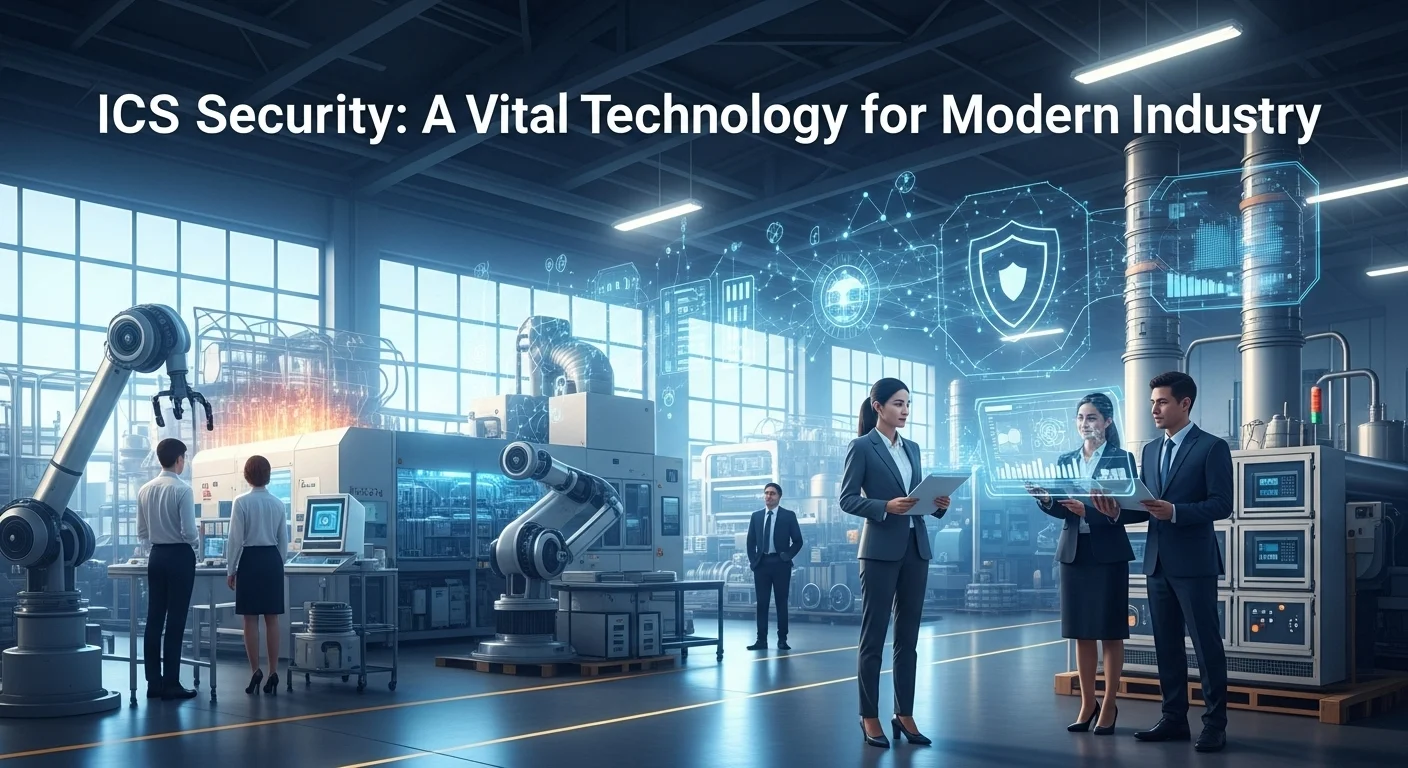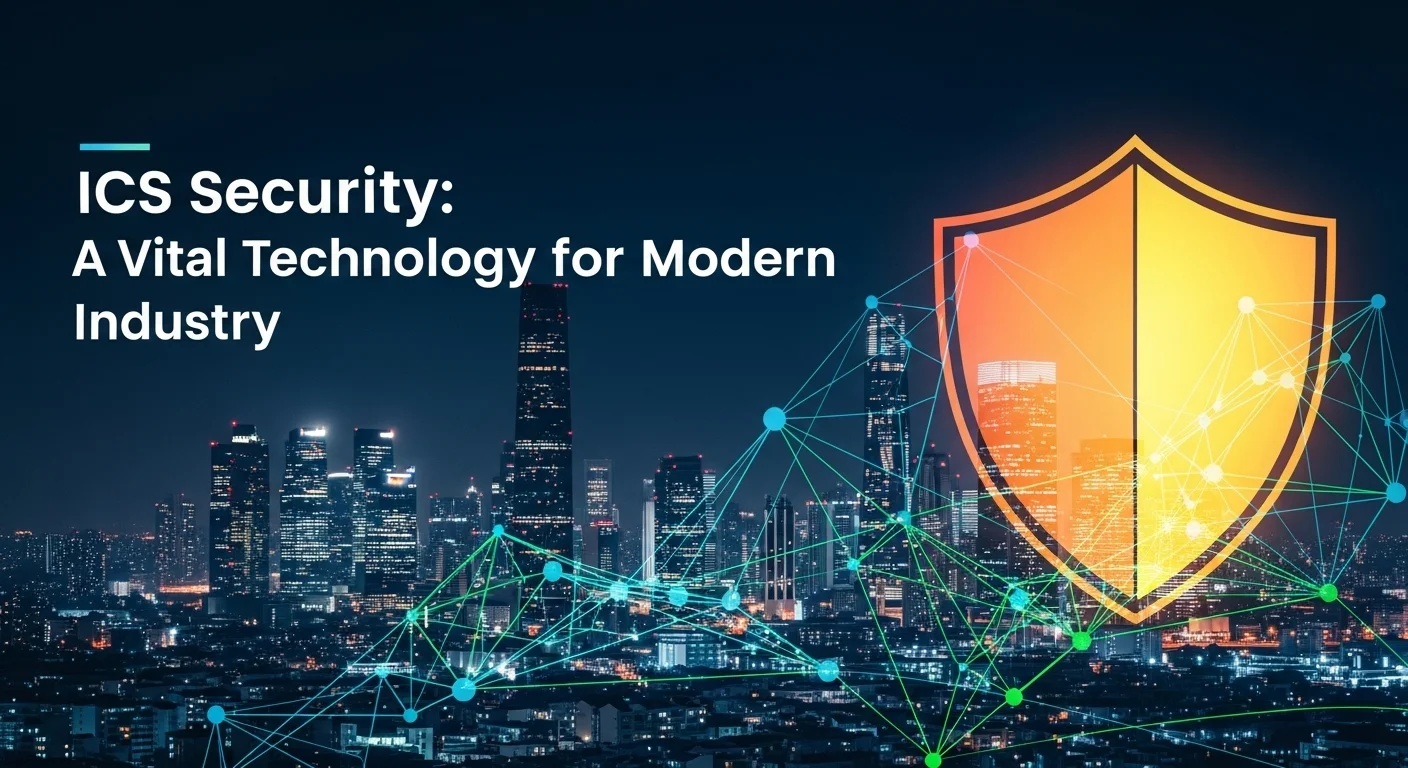What is ICS Security? A Plain-English Guide for Protecting Our Modern World

Executive Summary
I’ve spent years in the trenches of cybersecurity, and I can tell you that the most important battles aren't always about protecting data—they're about protecting the physical world. The power plant that lights your city, the factory that builds your car, the facility that cleans your water—they all run on Industrial Control Systems (ICS). For a long time, we thought these systems were safe because they were disconnected from the internet. That's no longer true. Now, protecting them is one of the most critical challenges of our time. This guide is for anyone who wants to understand what ICS security is all about. We’ll cut through the jargon and talk about the real-world risks, the smart strategies businesses are using, and the steps we can take to safeguard the technology that runs our lives.
Table of Contents
Table of Contents
- What is ICS Security? A Real-World Perspective
- When Two Worlds Collide: The IT and OT Convergence
- Why Strong Industrial Security is a Business Superpower
- Building Your Fortress: A Technical Guide to ICS Security
- Smart Strategies: Beyond the Technology
- Practical Tips for Mastering ICS Security Today
- Essential Tools and Resources to Get You Started
What is ICS Security? A Real-World Perspective
At its heart, Industrial Control System (ICS) Security is about protecting the technology that controls the physical world. Think about the massive, complex machinery in power plants, water treatment facilities, manufacturing lines, and transportation grids. These are all run by a combination of hardware and software known as Operational Technology (OT). ICS security is the specialized field of cybersecurity dedicated to keeping that OT safe. For years, I heard people talk about these systems being 'air-gapped,' meaning they were physically isolated from the internet and corporate networks. It was a comforting myth.
The reality is that this air gap no longer exists for most. The push for greater efficiency, remote access, and data analysis has connected these industrial systems to the outside world. While this connectivity brings amazing benefits, it also opens a Pandora's box of cyber threats. A successful attack here isn't about stolen credit card numbers; it's about real-world, physical consequences. We've seen it happen. The Colonial Pipeline attack halted fuel supply to an entire coast, and the infamous Stuxnet worm caused physical damage to nuclear centrifuges. These aren't hypotheticals; they are stark reminders that protecting our industrial infrastructure is a matter of public safety and economic stability.
When Two Worlds Collide: The IT and OT Convergence
For a long time, Information Technology (IT) and Operational Technology (OT) lived in separate universes. IT departments managed emails, servers, and data with a focus on confidentiality. Their world moves fast, with frequent software updates and hardware refreshes every few years. OT, on the other hand, is the world of engineers. They manage systems designed to run reliably for 20 years or more, where the absolute top priorities are safety and keeping the process running without interruption. You can't just reboot a power grid controller because a security patch is available.
When these two worlds merge, you get friction. IT security practices, like aggressive patching, can be dangerous in an OT environment. This is where the specialized discipline of industrial cybersecurity becomes so critical. It requires a unique team—people who understand both network security and the industrial process itself. The goal isn't just to bolt on IT security measures but to intelligently adapt them to protect the machinery without compromising its core function of being safe and reliable.
Why Strong Industrial Security is a Business Superpower
I often tell executives that investing in robust ICS security isn't just a defensive move; it's a powerful business enabler. The most obvious benefit is resilience. By preventing cyber incidents, you avoid crippling downtime, which in a manufacturing plant can mean millions in lost revenue per hour. You're also protecting your secret sauce—the proprietary formulas and processes that give you a competitive edge.
Beyond that, it's about trust and compliance. Regulations are getting stricter globally, and failing to protect critical infrastructure can lead to massive fines. But more importantly, a strong security posture shows your customers and partners that you are a reliable and responsible operator. It becomes a competitive advantage. As we move deeper into Industry 4.0, harnessing technologies like AI and the cloud for optimization depends entirely on having a secure foundation. Strong security allows you to innovate safely, ensuring that your pursuit of efficiency doesn't open the door to disaster.

Building Your Fortress: A Technical Guide to ICS Security
When I'm brought in to assess an industrial environment, I don't start with fancy tools. I start with the blueprint. A strong defense is built on a smart, defensible architecture. It's about making it as difficult as possible for an intruder to get to your most critical assets. This involves a mix of strategic network design and essential security technologies tailored for the industrial world.
Network Segmentation and the Purdue Model
The biggest mistake I see is a 'flat' network, where the front office email server is on the same network as the controllers running the assembly line. It’s a disaster waiting to happen. The solution is network segmentation: dividing your network into isolated zones. The classic blueprint for this is the Purdue Model. Think of it like a secure building with different floors:
- Level 0 & 1 (The Plant Floor): This is where the physical work happens—the sensors, motors, and the local controllers (PLCs) that directly manage them.
- Level 2 (Supervisory): This is the control room, with the Human-Machine Interfaces (HMIs) and SCADA systems that operators use to oversee the process.
- Level 3 (Site Operations): This floor houses systems that manage the entire site, like data historians and engineering workstations.
- Level 3.5 (The DMZ): This is the crucial buffer zone. It’s a highly controlled lobby that sits between your factory (OT) and your corporate office (IT). No one gets through without being checked.
- Level 4 & 5 (The Corporate Network): This is the traditional IT world of business systems, email, and internet access.
By enforcing strict rules about who can talk to whom between these levels, primarily using firewalls in the DMZ, you contain threats. A ransomware attack that hits your email system should never be able to cross the DMZ and shut down your plant floor.
Essential Security Technologies
Once your architecture is sound, you layer on specific technologies. These are the guards, gates, and cameras of your digital fortress:
- Industrial Firewalls & Data Diodes: Your firewalls are the gatekeepers at the boundaries of each network segment. But these aren't your average office firewalls; they need to understand industrial languages (protocols) to be effective. For ultimate security, a data diode acts as a one-way door, allowing data to flow out of the OT network for monitoring but making it physically impossible for anything to flow back in.
- Intrusion Detection Systems (IDS): Think of an IDS as a security guard who is fluent in the language of your machinery. It listens to the network chatter and can spot an unauthorized or dangerous command, alerting you before physical damage can occur.
- Asset Inventory and Visibility: You can't protect what you can't see. The first step is always to get a complete, detailed map of every single device on your network. Passive monitoring tools are perfect for this, as they listen to the network to identify assets without any risk of disrupting operations.
- Secure Remote Access: Your vendors and engineers need to get in, but that's a common entry point for attackers. A modern solution is essential, one that requires multi-factor authentication (MFA) and grants temporary, specific access only to the machine they need to work on, all while recording the session.
Smart Strategies: Beyond the Technology
Technology is only half the battle. A truly resilient program is woven into the fabric of the business. My advice is to stop trying to invent a security program from scratch. Instead, stand on the shoulders of giants by adopting established frameworks.
- NIST Cybersecurity Framework (CSF): This is the Rosetta Stone for cybersecurity. It breaks down the work into five simple functions: Identify, Protect, Detect, Respond, and Recover. It gives everyone, from the plant manager to the CEO, a common language to talk about risk.
- ISA/IEC 62443: This is the global gold standard for industrial security. It's a detailed set of standards covering everything from how to build a secure device to how to operate a secure facility. It’s the playbook for achieving a mature security posture.
- MITRE ATT&CK for ICS: This is like having the attackers' playbook. It’s a database of the real-world tactics and techniques hackers use to attack industrial systems. By studying it, your security team can learn to anticipate an attacker's next move and build defenses to counter it.
When you ask for budget, don't lead with technology. Lead with business risk. Frame the investment as a way to protect revenue, ensure operational uptime, and enable future growth. When the IT and OT teams present a unified front, speaking the language of business risk and resilience, leadership is far more likely to listen.

Practical Tips for Mastering ICS Security Today
Getting started with industrial security can feel overwhelming, but it's a journey of continuous improvement. It’s about building a strong culture, not just buying new boxes. Here are some of the most effective strategies I've seen work time and time again, which you can start implementing to make a real difference in your organization's resilience.
Best Practices for a Mature Security Program
- Build a Complete Asset Inventory: I've said it before, and I'll say it again: you cannot protect what you do not know you have. This is step one, always. Use tools designed for industrial networks to passively discover and map out every controller, workstation, and network switch. Document firmware versions and software. This map is the foundation for everything else.
- Aggressively Segment Your Network: A flat network is an open invitation for an attacker. Use the Purdue Model as your guide and use firewalls to create secure zones. Isolate your most critical processes. The goal is simple: if one area is breached, the fire doors slam shut, containing the damage and preventing it from spreading across the entire plant.
- Lock Down Access Control: Apply the principle of 'least privilege.' Every person and every system should only have the bare minimum access required to do their job. This isn't just about strong passwords; it's about deploying multi-factor authentication (MFA) wherever possible, especially for remote access. And don't forget physical security—a locked server cabinet is a simple but powerful control.
- Create a Practical Vulnerability Management Plan: Your industrial environment will have vulnerabilities; that’s a given. Many systems can't be easily patched. The key is to take a risk-based approach. Identify the flaws, figure out which ones pose a real threat to your operations, and prioritize. If you can't patch, use 'compensating controls' like enhanced monitoring or stricter network rules around that vulnerable asset.
- Develop and Practice an Incident Response Plan: Hope is not a strategy. You need a clear, written plan for what to do when a cyber incident happens. This plan must be unique to your OT environment, with the primary goals being to ensure human safety and maintain operations. Most importantly, you have to practice it. Run tabletop exercises with both your IT and OT teams so that when a real crisis hits, everyone knows their role.
- Enable Continuous Monitoring and Threat Detection: You can't fight an enemy you can't see. Deploy security monitoring tools that are built for OT. These solutions understand industrial protocols and can spot the subtle signs of an attack that standard IT tools would miss. This gives you the early warning you need to react before a minor issue becomes a catastrophe.
Essential Tools and Resources to Get You Started
Essential Business Tools and Platforms:
- OT Security Platforms: Companies like Dragos, Nozomi Networks, and Claroty have built incredible platforms that give you that single pane of glass. They handle asset discovery, threat detection, and vulnerability management all in one place, specifically for industrial environments.
- Next-Generation Firewalls (NGFWs): Look to vendors like Palo Alto Networks or Fortinet for firewalls that have industrial protocol inspection capabilities. They act as intelligent gatekeepers for your network segments.
- Data Diodes: For your most sensitive systems, where you need to send data out but guarantee nothing gets in, hardware like a data diode from Waterfall Security is the ultimate one-way street.
Quality External Resources:
Knowledge is power, and some of the best resources are free. I constantly point my clients to the work being done by the U.S. Cybersecurity and Infrastructure Security Agency (CISA). Their Industrial Control Systems page is a treasure trove of alerts, best practices, and guidance. It's an invaluable resource for any organization in this space. Additionally, organizations like the SANS Institute offer world-class training and research on industrial cybersecurity.
Ultimately, a secure technology experience in the industrial world comes from a cultural shift. It’s about moving from a reactive to a proactive mindset, where security is considered at every stage. By combining these proven practices with the right tools and a commitment to learning, you can turn your security posture from a source of anxiety into a genuine strategic asset, ready for the future of industry.
Expert Reviews & Testimonials
Sarah Johnson, Business Owner ⭐⭐⭐
The information on ICS Security is a good starting point, but as a small business owner, I'd love to see more case studies on how we can implement this on a smaller budget.
Mike Chen, IT Consultant ⭐⭐⭐⭐
This was a solid overview of ICS Security. As an IT consultant often bridging the gap with OT teams, this helped me understand their priorities better. Some of the technical concepts could be broken down even more, but it's a great resource.
Emma Davis, Tech Expert ⭐⭐⭐⭐⭐
Fantastic article! I'm specializing in industrial cybersecurity, and this was an incredibly comprehensive and clearly written piece on ICS Security. It connected all the dots for me. Highly recommend.



